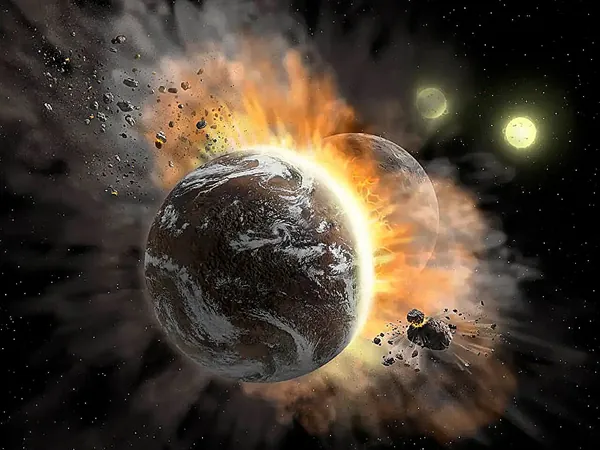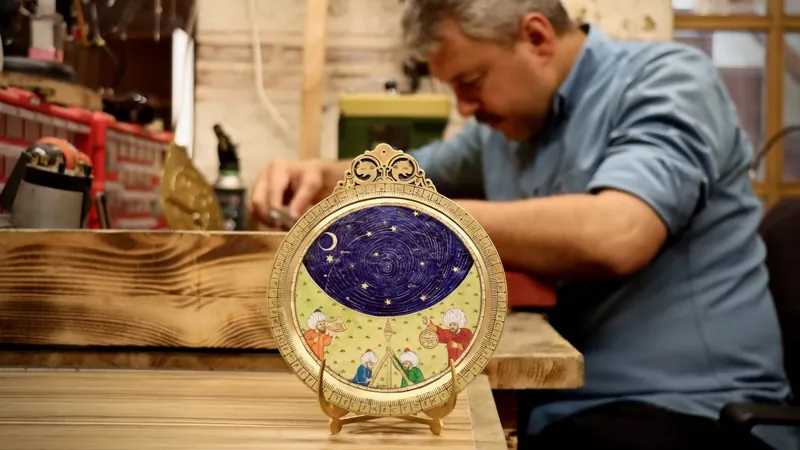
Unraveling the Secrets of Planetary Collisions: A New Way to Detect Cosmic Quakes!
2025-05-08
Author: Emma
Peering into the past of our chaotic solar system can be as simple as gazing at the moon, whose surface is riddled with craters from relentless cosmic collisions. Scientists believe that the violent history of impacts wasn't just isolated to Earth—this chaotic dance of debris also plagued the developmental stages of many young solar systems. A groundbreaking new study explores this concept through a simulated collision between two massive planets and how it might echo through the cosmos.
The Collision that Shook the Stars
The research, published in a paper titled "Seismic Oscillations Excited by Giant Impacts in Directly-Imaged Giant Planets," reveals just how colossal these planetary cores can be, potentially containing over 100 times the mass of Earth in solid material. These gargantuan exoplanets likely amassed their massive cores by merging with several smaller planetary bodies—each carrying around 10 Earth masses—during their early formation.
Astronomers simulated an impactful scenario between a younger, smaller gas giant and an older, more massive counterpart, aiming to assess whether such a cataclysm could create long-lasting seismic waves detectable by the James Webb Space Telescope (JWST). The simulation revolves around two key questions: Do these enormous impacts generate significant seismic waves, and can the JWST detect the aftereffects?
From Seismic Waves to Stellar Light
While the JWST isn't set up to detect seismic waves directly, it excels at measuring light changes with incredible precision. If seismic waves are powerful enough, the planet’s brightness may fluctuate as a byproduct of these cosmic disturbances. As the researchers note, these planet-scale impacts could generate detectable seismic oscillations in exoplanets that can be studied through phenomena like luminosity changes.
Spotlight on Beta Pictoris b
One exoplanet stealing the spotlight in this research is Beta Pictoris b, a young super-Jupiter weighing in at about 13 Jupiter masses and aged between 12 to 20 million years. Its interesting makeup is enriched with heavy metals due to what scientists describe as "strong planetesimal enrichment." This could mean that ongoing insights into the planet's internal structure are just waiting to be uncovered.
The researchers conducted detailed simulations, depicting a Neptune-sized planet with 17 Earth masses colliding with Beta Pictoris b, leading to an accumulation of heavy metals—potentially ranging from 100 to 300 Earth masses in total.
Long-Lasting Echoes and Cosmic Discoveries
As they observed seismic activity triggered by such impacts, the researchers discovered that these quakes could resonate for millions of years, maintaining a pace that aligns with the young planet’s age. The JWST could potentially catch noticeable variations in Beta Pictoris b's brightness if such a collision had occurred within the last 9 to 18 million years.
This novel method of utilizing seismic waves as a probe into the interiors of exoplanets serves as an innovative leap in planetary science. By examining seismic oscillations, astronomers can not only estimate bulk densities but also identify regions of stable stratification within these massive worlds.
Implications Beyond Impacts
Interestingly, this research opens doors to other potential applications, such as understanding planetary migrations. As the authors highlight, impacts aren't the only means to inspire oscillations; the fascinating processes of high eccentricity migration could also play a role, where gravitational forces from a host star lead to significant oscillations in these distant worlds.
In essence, this research offers a fresh perspective into the tumultuous lives of giant planets, beckoning us to look deeper into the cosmos and transform our understanding of planet formation and structure.









 Brasil (PT)
Brasil (PT)
 Canada (EN)
Canada (EN)
 Chile (ES)
Chile (ES)
 Česko (CS)
Česko (CS)
 대한민국 (KO)
대한민국 (KO)
 España (ES)
España (ES)
 France (FR)
France (FR)
 Hong Kong (EN)
Hong Kong (EN)
 Italia (IT)
Italia (IT)
 日本 (JA)
日本 (JA)
 Magyarország (HU)
Magyarország (HU)
 Norge (NO)
Norge (NO)
 Polska (PL)
Polska (PL)
 Schweiz (DE)
Schweiz (DE)
 Singapore (EN)
Singapore (EN)
 Sverige (SV)
Sverige (SV)
 Suomi (FI)
Suomi (FI)
 Türkiye (TR)
Türkiye (TR)
 الإمارات العربية المتحدة (AR)
الإمارات العربية المتحدة (AR)